Finally we’re seeing some sun in Denmark. We were in Copenhagen last week and had beautiful weather the whole time, which is a first. Usually it rains nonstop every time we’re there. Though it’s a little cooler and cloudier here in Aarhus, I can finally glimpse summer around the corner. So in honor of the coming summer, I thought I’d make a little list of what this turning of the seasons means for someone like me living in Denmark:
- Light! June 21st is the longest day of the year, and every day we get closer to that date we’re seeing longer and longer nights. We get almost 3 minutes more sunlight every day, to be exact. Tonight, the sun isn’t supposed to set until 9:47pm, and the twilight lingers until 10:30 or so. After a dark winter and gloomy spring, this extra light is very much appreciated.

A picture of Marselisborg Lystbådehavn at sunset. This was taken at about 9:40pm over the weekend.
- Parties in the park. The sun is so much appreciated that the minute work is over people flood the parks of Denmark to hang out in the sun. I’m in no way exaggerating. It looks like people waiting for the fireworks to start on the 4th of July. In Copenhagen we stayed near the King’s Garden by Rosenborg, and at 2pm people started trickling in. By 5pm, the park was PACKED. Of course, we were right there along with everyone, enjoying our pizza al fresco.


Who puts salad on a pizza?!
- Late night walks. Because of the light nights, we’ve started taking more walks after dinner, even as late as 9pm, while the sun is setting. It’s really fantastic.

- Sunglasses. (Is this really the fourth item on the list that has to do with the increased sunlight? Why yes, yes it is. It really is that important.) I don’t know if this is just me, but I swear the sunlight here is stronger or brighter or something. I noticed this when we first arrived last summer, too. As a result, if I go outside for a few hours without my sunglasses, I’m guaranteed to get a headache. So now my sunglasses, which I never used to wear in the US, go on as soon as I leave the house. It has the added benefit of making me look really cool.

Yep, super cool.
- Flowers. They enjoy the sun, too, and they are everywhere right about now and soooo pretty.

- Strawberries. The coming summer means that we’re starting to see more variety in the produce at the grocery store. I actually saw whole pineapples the other day! (And bought one immediately.) And bing cherries. Those are my favorite. I can’t wait until later in the season when they arrive really ripe. But the one most important fruit for a Danish summer is the Danish strawberry. They’re really big on strawberries around here, and I have to say that I don’t blame them. I bought this batch just the other day, and they are without a doubt some of the best strawberries I’ve ever eaten. Yum!

- Softis. It’s like someone took your everyday soft serve ice cream, stirred in a healthy portion of whipped cream, and served it to you on a cone. It’s the traditional Danish ice cream and a special summer treat. And it’s delicious. But the Danes love ice cream of any kind, and the minute it is even a little warm and sunny outside you’ll see people lined up out the door to get some. The only kind of ice cream I’ve had trouble finding here is the harder kind that’s more typical in the US. We’ve pretty much had to buy some (veeeery expensive) Ben & Jerry’s cartons at the store if we’re craving that texture. But it’s not really necessary because the soft ice cream (resembling gilato) that is all over in Aarhus is really yummy.

Nom nom nom. The strawberry swirl is our favorite flavor.
So that, so far, is what late spring/early summer in Denmark means for us. Hopefully soon we’ll get to try some other Danish summer traditions like grilling outside and visiting the West coast for a dip in the ocean. But we’re pretty happy with what we’ve got so far.








 Unfortunately, this part of our trip was marred by a little accident. We didn’t realize until we dropped the car off in Bruges that Brian had left both his passport and his drivers’ license at the rental place in Arnhem! Quelle horreur! Luckily, the lady at Ace Rent a Car was veeeery nice and helped us contact the guy who rented us the car (and failed to return the documents), who promised to overnight the two document to our next and last hotel in Brussels. So off we went with lighter hearts to discover Bruges. And discover it we did.
Unfortunately, this part of our trip was marred by a little accident. We didn’t realize until we dropped the car off in Bruges that Brian had left both his passport and his drivers’ license at the rental place in Arnhem! Quelle horreur! Luckily, the lady at Ace Rent a Car was veeeery nice and helped us contact the guy who rented us the car (and failed to return the documents), who promised to overnight the two document to our next and last hotel in Brussels. So off we went with lighter hearts to discover Bruges. And discover it we did.





























